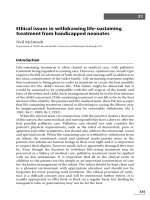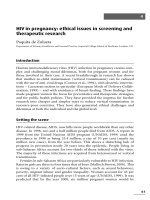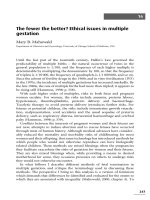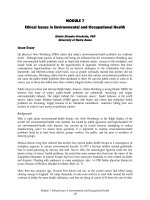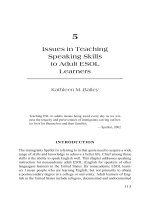Ethical issues in withdrawing life-sustaining treatment from handicapped neonates
Bạn đang xem bản rút gọn của tài liệu. Xem và tải ngay bản đầy đủ của tài liệu tại đây (137.51 KB, 12 trang )
21
Ethical issues in withdrawing life-sustaining
treatment from handicapped neonates
Neil McIntosh
Department of Child Life and Health, University of Edinburgh, Edinburgh, UK
Introduction
Life-sustaining treatment is often classed as medical care, with palliative
treatment being regarded as nursing care. However, optimal care of each type
requires the full involvement of both medical and nursing staV in addition to
the close commitment of the wider family. Life-sustaining treatment implies
that treatment is being given in order to maintain or create the best possible
outcome for the child’s future life. This future might be abnormal but it
would be assumed to be compatible with the self-respect of the family and
later of the infant and child. Such management should be in the best interests
of the child concerned. If life-sustaining treatment is not felt to be in the best
interest of the child by the parents and the medical team, then UK law accepts
that life-sustaining treatment (aimed at alleviating or curing the illness) may
be inappropriately burdensome and may be reasonably withdrawn (Re J,
1981; Re C, 1989; Re J, 1992).
When the clinical team (in conjunction with the parents) makes a decision
of this nature, the same medical and nursing staV then have a duty to oVer the
best possible palliative care. Palliative care should not only consider the
patient’s physical requirements, such as the relief of discomfort, pain or
agitation and other symptoms, but should also address the emotional, social
and spiritual needs. When life-sustaining care is withheld or withdrawn from
an infant, the emotional, social and spiritual needs pertain more to the
parents, but infants are human beings in their own right and it is important
to respect their dignity, however small, sick or apparently damaged they may
be. Even though the decision to withdraw life-saving treatment may be
perceived as a failure of medical care, palliative treatment must be applied
with no less enthusiasm. It is important that all in the clinical team in
addition to the parents see this simply as an important reorientation of care
for the better management of the infant. The infant should be kept clean and
in a pleasant environment with appropriate attention and should not be
forgotten for more pressing ward problems. The ethical provision of nutri-
tion is a diYcult concept area and will be mentioned further below. It is
usually appropriate to oVer food or Xuid on a regular basis, but feeding by
nasogastric tube or gastrostomy may not be for the best.
335
Background
Considerations about withholding or withdrawing life-saving medical treat-
ment from a handicapped newborn may arise at two diVerent times. At the
moment of birth abnormalities may be so gross as to be obviously incompat-
ible with any length or quality of life to even the most junior medical or non-
medical person present. Such problems would include anencephaly (now
rare in many countries due to antenatal screening programmes) or the baby
with cyclops and a proboscis. In these instances cerebral function will be
severely compromised even if survival is possible. Multiple and gross abnor-
malities such as sirenomyelia (the mermaid) will also be evident at birth,
where, even though the head may look normal indicating possible cerebral
potential, there are the gross deformities of lower limbs. Closer observation
will reveal abnormalities of the genitalia and anal region, and, in this
example, there would be severe gastrointestinal abnormalities and renal
agenesis making death inevitable from renal failure within a very few days.
Consideration of withholding or withdrawing life-saving medical treat-
ment may also arise later in the neonatal period. This may be because less
obvious but equally compromising abnormalities have come to light, e.g. the
grosser forms of hypoplastic left heart syndrome, or because a marked lack of
cerebral potential following birth injury or birth asphyxia becomes obvious.
Decisions at this time can take no account of the wishes or feelings of the
child him- or herself; parents have the duty of decision-making in conjunc-
tion with the clinical team. There are three broad areas where such decisions
may arise.
∑ Firstly, the extremely preterm infant (born, for example, at 23 weeks’
gestation), where although life may be possible, it may depend on many
months of highly invasive treatment, during which the chances of death are
signiWcant and morbidity more than likely. At this gestation the recent UK
National EPICURE study has indicated only a six per cent survival of
liveborn infants and in the survivors a 60 per cent incidence of disability
(Wood and Marlow, 1999). Although medical management of the ex-
tremely immature infant with intensive care may improve the outcome, as
the boundaries of gestation are pushed back, the anxieties about these
outcomes are also moved back. It seems unlikely that this issue will
disappear.
∑ The second area is that of multiple congenital abnormality – often evident
right from the moment of birth (see above). These infants are becoming
fewer in number with the introduction of antenatal physical abnormality
scans and blood tests. When such diagnoses are picked up in early preg-
nancy, counselling followed by termination is often now a logical and
legitimate choice for the parents.
∑ The third area in which these issues arise are the term babies who are
336 N. McIntosh
severely asphyxiated around the time of birth. Even with the best obstetric
management, occasional infants are delivered in a severely neurologically
depressed condition. Such infants in the past have been labelled as having
suVered birth asphyxia. This reXex diagnosis is not helpful and in only a
minority of cases is it likely to be accurate. In the majority of cases the
attachment of this phraseology leads to a Wnger-pointing medico-legal
exercise which can be expensive both in cash terms and in terms of
emotional stress on both the parents and the involved staV. Epidemiologi-
cal data and careful examination of the individual case more usually fail to
reveal any mismanagement, and it is now believed that many of these cases
may represent babies damaged antenatally, who then have diYculty sus-
taining the stress of a normal labour and delivery (Michaelis et al., 1980;
Coorssen et al., 1991). This problem may be reduced by better obstetric
monitoring, but how to do this is not established – indeed, it is one of the
Holy Grails of obstetric care. Although ‘birth asphyxia’ has become far less
common in the last 50 years, we have now reached a plateau for the last
10–15 years. Unless a more sophisticated monitoring technique is develop-
ed, these problems, and hence the ethical questions they raise about
withdrawal of therapy around them, will continue.
The outlook for these three groups should be considered on the basis of
their intellectual and physical future. Since DuV and Campbell wrote their
seminal paper in 1973 when they described (or revealed) that 14 per cent of
infants at the Yale University Neonatal Service who died did so because of the
withdrawal of life-saving medical treatment, the number of such cases has
risen (DuV and Campbell, 1973). Whitelaw in 1986 monitored a 30 per cent
active withdrawal in such situations (Whitelaw, 1986). Hazeborek et al.
(1993) and Caniano et al. (1995), writing in the late 1980s, suggested a
prevalence of approximately 50 per cent; more recently, Wall and Partridge
recorded 75 per cent (Wall and Partridge, 1997). In the western world at least,
this practice is established, and it is likely to occur elsewhere.
Rights and duties of parents and doctors in the newborn
period
The newborn infant is unable to make choices, so it is generally assumed that
the parent will give or refuse consent on his or her behalf. This is perhaps
logical, as the parents can generally be expected to have signiWcant interests in
their children and can be expected to safeguard these interests. Parental rights
are not absolute, however, and infants are now recognized to have the same
rights to life, liberty and autonomy as others. Although paternalism is
justiWed, the choice is on the child’s behalf and must represent the child’s best
337Ethical issues in withdrawing life-sustaining treatment
interest at the time and for the future. Even if the parents have strongly held
religious beliefs or other views, they are not at liberty to imperil their children
by their decisions. The Children Act 1989 lays more overt stress on parental
responsibility than on parental rights; the United Nations Convention on the
Rights of the Child (1989) also enshrines principles of respect for children
(particularly in Article 12) and has been ratiWed by the British government.
Doctors and nurses also have a duty of care that compels them to protect
their patient’s life and health. If the doctor fails in this duty, she or he may be
guilty of negligence, although a negligence action is not to be expected in
every case that turns out badly. The standard of competence expected of a
doctor is that he or she should act in accordance with practice accepted by a
responsible body of medical people skilled in that particular branch of
medicine, the ‘Bolam’ test for England and Wales (Bolam v Friern HMC,
1957) and the ‘Hunter and Hanley’ test for Scotland (Hunter v Hanley, 1955).
In other words, the specialist must practice with the ordinary skill of his or
her specialty. The acknowledgement that this is a special skill, and in the UK a
skill that follows considerable training, gives doctors alone the right to decide
whether a treatment is medically appropriate. Parents do not have the right to
demand treatments that a doctor may deem to be outside of the child’s best
interest, although they may refuse treatment which they view as not in the
child’s best interest. Doctors have no legal authority to institute treatments in
the absence of a valid consent from someone with parental responsibility, but
emergency treatment deemed to be in the infant’s best interest can be given.
Withdrawal of treatment that is life-saving would only in very rare circum-
stances be done without parental acceptance and consent. Thus communica-
tion, consisting of regular and frequent discussion by the clinical team with
the parents, is crucial to all decisions in the neonatal unit. Information at all
stages must be given in an understandable form to allow reason, deliberation
and comfortable decision-making. Decisions on withholding or withdrawing
life-sustaining treatment are unlikely to go well in the absence of previous
communication. This is not to say that responsibility for such decisions
should be left to the parents alone, but that it must be obvious that the
parents are in agreement before such decisions are enacted.
The issues
The principles of modern medical ethics, often taken to consist of autonomy,
beneWcence, non-maleWcence and justice (Gillon, 1986; Beauchamp and
Childress, 1994) are as important for the newborn, and the handicapped
newborn in particular, as for other age groups. The infant’s own autonomy is
largely replaced by ‘autonomy within the family’. The parents take on the
consenting role on behalf of their child for both therapy and research;
338 N. McIntosh
whereas the assent of the competent older child may be important (Re W,
1992), this is not an issue in infancy. BeneWcence and non-maleWcence relate
to a therapy being in the infant’s best interest, with a balance of beneWt
compared to harm – this is the crux of this chapter. Justice requires that the
infant is not prejudiced in any way by his or her state as an individual – a
treatment, if eVective and necessary, should not be dependent on race, social
background or ability to pay. Justice also demands that the standards of
decision-making are as rigorous for the infant, and the handicapped infant
especially, as for a sentient adult.
The Royal College of Paediatrics and Child Health have delimited three
areas where the withholding or withdrawing of life-sustaining treatment
might reasonably be considered in the newborn period (Royal College of
Paediatrics and Child Health, 1997).
(1) In the no hope or no chance situation, life-sustaining treatment is simply
delaying death without improving life quality or potential. If suVering is
not to any signiWcant extent alleviated, medical treatment would be
deemed inappropriate. There is no legal obligation for the doctor to
provide medical treatment in this situation which cannot be in the best
interest of the patient. Indeed if this is done knowingly, it is futile
treatment.
(2) The no purpose situation describes the case where the child’s potential of
having an extremely signiWcant degree of impairment is inevitable, and it
would not be reasonable to expect him or her to bear it. Such an
impossibly poor quality of life may relate to the future, in which case
treatment might reasonably not be initiated (e.g. ventilation for congeni-
tal myotonic dystrophy) or to the present, with the likelihood of it
continuing with no foreseeable improvement, in which case the treat-
ment might reasonably be withdrawn. This might apply to the severely
asphyxiated infant where microcephaly, profound developmental delay,
blindness and quadraplegia are believed to be inevitable. This could also
reXect conditions where brain damage is not necessarily the worrying
outcome. For instance, in severe myotonic dystrophy or for the ventila-
tor-dependent infant with broncho-pulmonary dysplasia in cor pul-
monale, compromise of potential cerebral function may not be a con-
cern, but the likelihood of getting the child oV the ventilator to any form
of independent existence may be negligible.
(3) The third case is the unbearable situation, where a family may feel that
further treatment is more than can be borne. They wish to have treat-
ment withdrawn or wish to refuse further treatment irrespective of
medical opinion. Parents may be able to recognize that it is reasonable to
put up with short-term suVering for a good later outcome. There is a
limit, however, to this tolerance – if there are likely to be repeated and
severe problems and invasive therapy, parents may feel that treatment
339Ethical issues in withdrawing life-sustaining treatment


